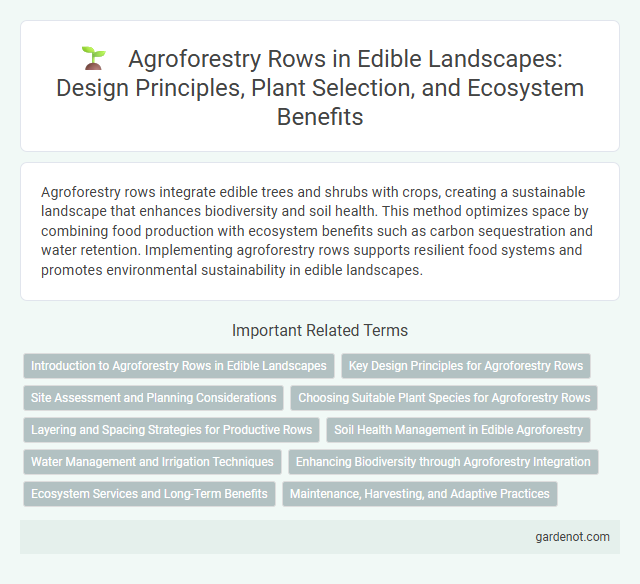Agroforestry rows integrate edible trees and shrubs with crops, creating a sustainable landscape that enhances biodiversity and soil health. This method optimizes space by combining food production with ecosystem benefits such as carbon sequestration and water retention. Implementing agroforestry rows supports resilient food systems and promotes environmental sustainability in edible landscapes.
Introduction to Agroforestry Rows in Edible Landscapes
Agroforestry rows integrate trees and shrubs with crops in edible landscapes to maximize biodiversity and enhance soil health. These multi-layered plantings optimize space by combining fruit and nut-bearing species with vegetables or herbs, promoting sustainable food production. The strategic arrangement in agroforestry rows improves water retention, reduces erosion, and supports beneficial wildlife habitats.
Key Design Principles for Agroforestry Rows
Agroforestry row design centers on maximizing biodiversity, soil health, and productivity by strategically layering plant species with complementary functions. Key design principles emphasize selecting nitrogen-fixing trees, deep-rooted perennials, and nutrient-accumulating shrubs to enhance soil fertility and water retention. Proper spacing ensures optimal light penetration and root competition management, fostering resilient, sustainable edible landscapes.
Site Assessment and Planning Considerations
Site assessment for agroforestry rows requires evaluating soil quality, sunlight exposure, and water availability to ensure optimal growth of diverse edible plants and trees. Planning considerations include selecting compatible species based on microclimate conditions and spatial arrangement to maximize yields and biodiversity within the edible landscape. Proper site analysis and strategic layout enhance resilience, productivity, and sustainability in agroforestry systems.
Choosing Suitable Plant Species for Agroforestry Rows
Selecting appropriate plant species for agroforestry rows involves prioritizing native trees and shrubs adapted to local soil and climate conditions to ensure resilience and productivity. Integrating nitrogen-fixing plants such as alder or acacia enhances soil fertility, while fruit-bearing species like mulberry or moringa provide edible yields and biodiversity benefits. Careful consideration of plant maturity rates and root structures is essential to optimize space utilization and minimize competition within the agroforestry system.
Layering and Spacing Strategies for Productive Rows
Agroforestry rows utilize strategic layering by combining canopy, understory, shrub, and groundcover plants to maximize edible yield and biodiversity within limited space. Proper spacing between layers ensures optimal sunlight penetration, air circulation, and root growth, promoting healthier plants and higher productivity. Implementing tailored spacing protocols improves resource use efficiency, soil health, and pest management in edible landscape agroforestry systems.
Soil Health Management in Edible Agroforestry
Agroforestry rows enhance soil health management by integrating diverse plant species that improve nutrient cycling and increase organic matter content. The root systems of trees and shrubs in these rows stabilize soil structure, reduce erosion, and promote beneficial microbial activity. This sustainable practice supports long-term soil fertility and increases resilience against climate variability in edible landscapes.
Water Management and Irrigation Techniques
Agroforestry rows enhance water management by improving soil moisture retention through layered vegetation that reduces evaporation and runoff. Incorporating drip irrigation systems within these rows delivers precise water directly to plant roots, optimizing water use efficiency and minimizing waste. Mulching with organic materials around trees and crops further conserves water by maintaining consistent soil humidity and preventing erosion in edible landscapes.
Enhancing Biodiversity through Agroforestry Integration
Agroforestry rows combine trees, shrubs, and crops to create diverse, multi-layered ecosystems that enhance habitat connectivity and support a wide range of pollinators, birds, and beneficial insects. This integration improves soil health by increasing organic matter and microbial activity, while also promoting natural pest control and reducing erosion. Implementing agroforestry rows in edible landscapes fosters resilience and productivity through ecological balance and increased species richness.
Ecosystem Services and Long-Term Benefits
Agroforestry rows enhance biodiversity by integrating trees with crops, promoting natural pest control and improving soil health through organic matter accumulation. These systems increase carbon sequestration, mitigate erosion, and regulate microclimates, contributing to sustained agricultural productivity. Long-term benefits include improved water retention, enhanced nutrient cycling, and greater resilience against climate change impacts.
Maintenance, Harvesting, and Adaptive Practices
Agroforestry rows require regular maintenance such as pruning, mulching, and soil fertility management to optimize plant health and yield. Harvesting practices must be timed according to crop maturity to ensure maximum nutritional value and regeneration capacity of perennial species. Adaptive practices, including crop rotation, pest control, and selecting resilient plant varieties, enhance the sustainability and productivity of edible landscape systems.
Agroforestry row Infographic

 gardenot.com
gardenot.com